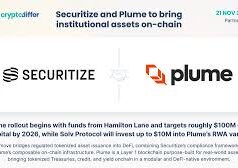In a historic moment for the cryptocurrency industry, Bitcoin (BTC) has shattered previous records, soaring to new all-time highs and captivating the attention of investors, technologists, and policymakers alike. This unprecedented rally, which has seen Bitcoin eclipse its prior peaks and cement its status as a global financial phenomenon, can be traced to a pivotal regulatory development: the U.S. Treasury’s decision to eliminate crypto broker reporting rules that would have imposed stringent transaction reporting requirements on decentralized finance (DeFi) platforms. Finalized after a Congressional vote earlier this year to revoke these regulations, this move has unleashed a wave of optimism, innovation, and capital inflows into the crypto market, with Bitcoin leading the charge. In this comprehensive blog post, we’ll dive deep into the details of this regulatory shift, explore its profound impact on Bitcoin’s price surge, analyze its implications for the broader crypto ecosystem, and consider what lies ahead for the world’s leading cryptocurrency and the DeFi revolution.
The Regulatory Landscape: A Battle for Decentralization
To understand the significance of the U.S. Treasury’s decision, we must first examine the regulatory context that set the stage for this landmark change. In recent years, governments worldwide have grappled with how to regulate the rapidly evolving cryptocurrency industry, balancing the need for consumer protection and tax compliance with the desire to foster innovation. In the United States, the Internal Revenue Service (IRS) has been particularly focused on ensuring that crypto transactions are properly reported for tax purposes, leading to the introduction of rules that classified certain crypto entities as “brokers” under IRS guidelines.
Under these proposed rules, DeFi platforms—decentralized protocols that enable users to lend, borrow, trade, and earn yield without intermediaries—would have been required to collect and report detailed customer transaction data to the IRS via Form 1099-DA. This would have included sensitive information such as user identities, wallet addresses, transaction amounts, and timestamps. For centralized crypto exchanges like Coinbase or Kraken, such reporting requirements are feasible, as these entities maintain custody of user funds and have direct access to customer data. However, applying the same framework to DeFi platforms posed significant challenges.
DeFi protocols, by design, operate without centralized control. They rely on smart contracts—self-executing code on blockchains like Ethereum—that facilitate transactions without a single entity overseeing the process. Many DeFi platforms lack the infrastructure to collect user data, and their open-source, permissionless nature allows users to interact anonymously using pseudonymous wallet addresses. Imposing broker reporting rules on DeFi would have required protocols to overhaul their architecture, potentially undermining the very principles of decentralization, privacy, and accessibility that make DeFi so transformative.
The crypto community, including developers, advocacy groups, and users, pushed back fiercely against these rules. Organizations like the Blockchain Association, Coin Center, and the DeFi Education Fund argued that classifying DeFi platforms as brokers was not only impractical but also stifled innovation and violated the ethos of decentralization. Their efforts culminated in a rare Congressional vote earlier this year to revoke the DeFi reporting requirements, a decision that the U.S. Treasury has now finalized. While centralized crypto brokers remain subject to separate IRS reporting obligations, DeFi platforms are officially exempt, marking a significant victory for the industry and a turning point for the crypto market.
Why This Regulatory Shift Fueled Bitcoin’s Surge
At first glance, the removal of DeFi reporting rules might seem like a niche regulatory adjustment with little direct relevance to Bitcoin, which operates on its own blockchain and is not inherently tied to DeFi protocols. However, the broader implications of this decision have created a perfect storm of bullish sentiment, propelling Bitcoin to new all-time highs. Let’s break down the key reasons why this regulatory change has had such a profound impact on BTC:
- Reinforcing Bitcoin’s Decentralized Ethos
Bitcoin was created in 2009 by the pseudonymous Satoshi Nakamoto as a decentralized, censorship-resistant alternative to traditional financial systems. Its value proposition rests on principles of user sovereignty, financial freedom, and resistance to overreaching government control. The Treasury’s decision to exempt DeFi platforms from broker reporting rules aligns closely with these principles, signaling that regulators are beginning to recognize the unique nature of decentralized systems. This regulatory clarity strengthens the narrative that Bitcoin—and the broader crypto ecosystem—can thrive without suffocating oversight, boosting investor confidence in BTC as a store of value and hedge against centralized control. For Bitcoin maximalists and long-term holders, this development reaffirms their belief in BTC’s enduring relevance in a world increasingly dominated by digital finance. - Catalyzing DeFi’s Growth and Bitcoin’s Role
DeFi has emerged as one of the most dynamic sectors of the crypto industry, with billions of dollars in total value locked (TVL) across protocols like Uniswap, Aave, and Curve. By removing the threat of burdensome reporting requirements, the Treasury’s decision paves the way for DeFi to flourish, attracting more users, developers, and capital to the ecosystem. Bitcoin, as the largest and most liquid cryptocurrency, plays a critical role in this growth. Many DeFi platforms integrate Bitcoin through wrapped tokens, such as Wrapped Bitcoin (WBTC), which allows BTC holders to participate in yield-generating opportunities like lending, staking, and liquidity provision. As DeFi adoption accelerates, demand for Bitcoin as a gateway asset and store of value is likely to increase, driving its price higher. Moreover, the influx of new users into DeFi often begins with Bitcoin purchases, as BTC remains the most accessible and widely recognized entry point into the crypto market. - Alleviating Regulatory Uncertainty
Regulatory uncertainty has long been a headwind for the crypto market, with investors wary of potential crackdowns, unclear compliance requirements, or punitive tax policies. The Treasury’s decision to exclude DeFi from broker reporting rules provides a rare moment of regulatory clarity, signaling that the U.S. government is willing to adopt a more nuanced approach to crypto regulation. This clarity reduces perceived risks for both institutional and retail investors, encouraging capital inflows into Bitcoin and other cryptocurrencies. Institutional players, in particular, have been closely monitoring the regulatory landscape, and this development has likely emboldened hedge funds, asset managers, and corporations to increase their BTC allocations. The success of spot Bitcoin ETFs, which have seen record inflows in recent months, underscores the growing institutional appetite for Bitcoin in a more predictable regulatory environment. - Amplifying Market Sentiment and Momentum
The Congressional vote and subsequent Treasury action represent a significant win for the crypto industry’s advocacy efforts. Organizations like the Blockchain Association and Coin Center have worked tirelessly to educate policymakers about the unique challenges of regulating DeFi, and their success in overturning these rules demonstrates the growing influence of the crypto community. This victory has fostered a sense of optimism and resilience in the market, with investors viewing it as evidence that the industry can navigate regulatory challenges. On platforms like X, posts celebrating the regulatory win and speculating on Bitcoin’s next price targets have fueled retail enthusiasm, creating a feedback loop of bullish sentiment. This combination of positive news, institutional FOMO (fear of missing out), and retail excitement has driven Bitcoin’s price to new heights, with technical indicators suggesting that the rally may have further room to run. - Global Implications and Bitcoin’s Borderless Appeal
The U.S. decision comes at a time when other jurisdictions, such as the European Union, Singapore, and Hong Kong, are also refining their crypto regulations. The perception of a more crypto-friendly global environment enhances Bitcoin’s appeal as a borderless asset, capable of transcending national boundaries and regulatory regimes. As countries compete to attract crypto innovation and investment, Bitcoin’s status as the world’s leading cryptocurrency positions it to benefit disproportionately from this global shift. Investors in regions with restrictive regulations may increasingly turn to Bitcoin as a hedge against local uncertainties, further driving demand and price appreciation.
The Market Reaction: A Perfect Storm for Bitcoin
The announcement of the Treasury’s decision sent shockwaves through the crypto market, with Bitcoin leading the charge. In the days and weeks following the news, BTC broke through key resistance levels, surpassing its previous all-time high and reaching unprecedented peaks. Several factors amplified this rally:
- Institutional Inflows: Institutional investors have increasingly embraced Bitcoin as a portfolio diversifier, with firms like BlackRock, Fidelity, and MicroStrategy holding significant BTC positions. The removal of DeFi reporting rules signaled a more favorable regulatory environment, prompting institutions to accelerate their Bitcoin investments. Spot Bitcoin ETFs, which have become a popular vehicle for institutional exposure, saw record inflows, further fueling the rally.
- Retail Frenzy: Retail investors, emboldened by the positive news and Bitcoin’s price momentum, piled into the market. Social media platforms like X buzzed with excitement, with hashtags like #BitcoinATH and #DeFi trending as users celebrated the regulatory win and speculated on BTC’s next milestones. This retail-driven FOMO added significant buying pressure, pushing Bitcoin’s price higher.
Technical Breakouts: From a technical analysis perspective, Bitcoin’s breakout above its previous all-time high triggered a wave of algorithmic trading and stop-loss orders, amplifying the upward momentum. Chart patterns, such as a bullish cup-and-handle formation, further supported the case for continued price appreciation.- Macro Backdrop: The broader macroeconomic environment also played a role. With inflation concerns lingering and central banks signaling potential rate cuts, Bitcoin’s narrative as a “digital gold” and inflation hedge resonated with investors. The DeFi deregulation news served as a catalyst, reinforcing Bitcoin’s appeal in a world of economic uncertainty.
Implications for DeFi and the Crypto Ecosystem
While Bitcoin has been the primary beneficiary of this regulatory shift, the implications extend far beyond BTC. The DeFi sector, which has grown into a multi-billion-dollar industry, stands to benefit immensely from the removal of reporting rules. Without the burden of IRS compliance, DeFi protocols can focus on innovation, user experience, and scalability, driving the adoption of decentralized financial services. This could lead to:
- Increased User Adoption: The absence of reporting requirements preserves the pseudonymous nature of DeFi, making it more attractive to privacy-conscious users. This could drive a surge in new users, particularly in regions with restrictive financial systems.
- Developer Innovation: Freed from the threat of regulatory overreach, DeFi developers can continue building cutting-edge protocols, from automated market makers to decentralized lending platforms. This innovation could unlock new use cases for Bitcoin, such as its integration into cross-chain DeFi ecosystems.
- Capital Inflows: As DeFi grows, it will attract more capital from both retail and institutional investors. This influx of liquidity could further boost demand for Bitcoin, as it remains a key on-ramp for crypto investors.
However, the distinction between DeFi and centralized brokers highlights the Treasury’s attempt to balance innovation with oversight. Centralized exchanges and custodians, which have clear custodial responsibilities, remain subject to IRS reporting requirements. This ensures that regulators can monitor transactions on centralized platforms while allowing DeFi to operate with greater freedom. For users, this means that DeFi platforms offer a degree of anonymity and flexibility not available on centralized exchanges, aligning with the original vision of cryptocurrencies.
The decision also sets a precedent for future regulatory battles. As governments worldwide grapple with how to regulate emerging technologies like DeFi, the U.S. Treasury’s approach could serve as a model for other jurisdictions. A balanced regulatory framework that respects the decentralized nature of crypto while addressing concerns like tax evasion and money laundering could unlock significant growth for the industry, benefiting Bitcoin and the broader ecosystem.
What’s Next for Bitcoin and DeFi?
As Bitcoin basks in its new all-time high, the question on everyone’s mind is: what’s next? While predicting short-term price movements is inherently uncertain, several trends suggest that the bullish momentum could continue:
- Sustained DeFi Growth: With regulatory barriers lowered, DeFi platforms are likely to see increased user adoption and capital inflows. This growth could drive demand for Bitcoin as a key asset within the DeFi ecosystem, particularly through wrapped tokens and cross-chain bridges.
- Institutional Momentum: The combination of regulatory clarity and Bitcoin’s strong performance is likely to attract more institutional investors, further legitimizing BTC as an asset class. The continued success of Bitcoin ETFs and corporate treasury allocations (e.g., MicroStrategy) could sustain upward pressure on prices.
- Technological Advancements: Innovations like the Lightning Network, Taproot, and layer-2 solutions are enhancing Bitcoin’s scalability, privacy, and functionality. These advancements make Bitcoin more attractive for both DeFi applications and everyday transactions, potentially driving broader adoption.
- Global Regulatory Trends: As other countries follow the U.S.’s lead in crafting crypto-friendly policies, Bitcoin’s global adoption could accelerate. Jurisdictions competing to become crypto hubs—such as Singapore, Switzerland, and the UAE—may create a more favorable environment for BTC investment and innovation.
- Macro Catalysts: Ongoing macroeconomic uncertainties, including inflation, currency devaluation, and geopolitical tensions, could further bolster Bitcoin’s appeal as a hedge against traditional financial systems. The DeFi deregulation news serves as a catalyst within this broader context, reinforcing Bitcoin’s role as a store of value.
Challenges and Risks to Consider
While the outlook for Bitcoin and DeFi is overwhelmingly positive, it’s important to acknowledge potential challenges:
- Regulatory Pushback: Although the DeFi reporting rules were repealed, regulators could introduce new measures targeting other aspects of the crypto industry. For example, stablecoins, anti-money laundering (AML) rules, or securities classifications could pose future hurdles.
- Market Volatility: Bitcoin’s price surges are often followed by periods of consolidation or correction. Investors should be prepared for volatility, as speculative trading and profit-taking could temper the rally.
- DeFi Risks: While DeFi offers immense potential, it also carries risks such as smart contract vulnerabilities, hacks, and rug pulls. These risks could impact investor confidence and indirectly affect Bitcoin’s price.
- Centralized Broker Scrutiny: The continued reporting obligations for centralized brokers could create a two-tiered market, where users gravitate toward DeFi for privacy but face stricter oversight on centralized platforms.
Conclusion: A New Era for Bitcoin and Decentralized Finance
The U.S. Treasury’s decision to remove crypto broker reporting rules for DeFi platforms has proven to be a game-changer for the cryptocurrency market, propelling Bitcoin to new all-time highs and igniting a wave of optimism across the industry. By alleviating regulatory burdens on decentralized protocols, this move has strengthened the case for decentralization, boosted investor confidence, and paved the way for continued growth in the DeFi sector. For Bitcoin, the regulatory clarity, combined with its enduring appeal as a store of value and gateway to the crypto ecosystem, has created a perfect storm, driving its price to unprecedented levels.
As we look to the future, the interplay between regulation, innovation, and market dynamics will continue to shape the crypto landscape. The Treasury’s decision marks a turning point, not only for DeFi but for the broader vision of a decentralized financial system. For Bitcoin investors, HODLers, and DeFi enthusiasts, this moment underscores the resilience and potential of cryptocurrencies to redefine finance. Whether you’re a seasoned crypto veteran or a curious newcomer, one thing is certain: the revolution is just beginning, and Bitcoin is leading the way.




























the Treasury’s move on DeFi reporting is a massive W for crypto!
Bitcoin over $120K and climbing! The Treasury’s DeFi rule rollback is a game-changer
The U.S. Treasury dropping those DeFi rules is huge for the space. But is this rally just policy hype
BTC smashing past $120K? Let’s go!